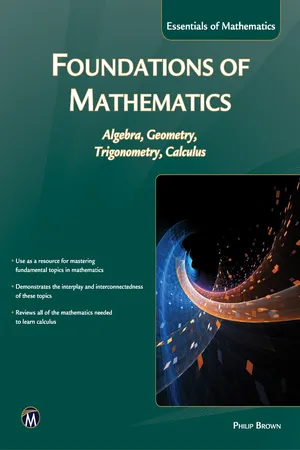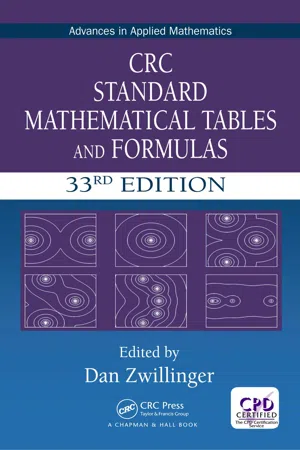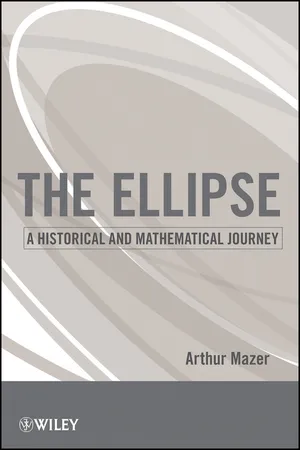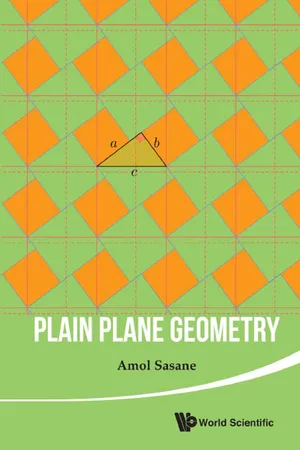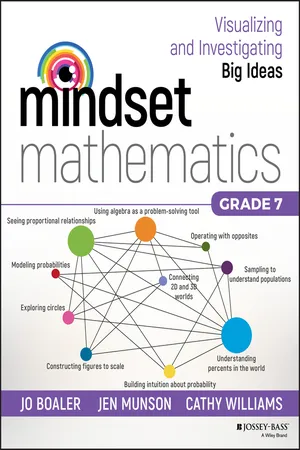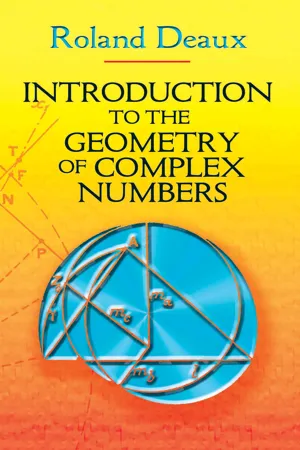Mathematics
Equation of a circle
The equation of a circle in the Cartesian coordinate system is given by (x - h)^2 + (y - k)^2 = r^2, where (h, k) represents the coordinates of the center of the circle and r is the radius. This equation allows for the representation and analysis of circles in the coordinate plane, providing a clear relationship between the circle's center, radius, and its equation.
Written by Perlego with AI-assistance
Related key terms
Related key terms
1 of 4
Related key terms
1 of 3
6 Key excerpts on "Equation of a circle"
- eBook - ePub
Foundations of Mathematics
Algebra, Geometry, Trigonometry and Calculus
- Philip Brown(Author)
- 2016(Publication Date)
- Mercury Learning and Information(Publisher)
2 = 1. We can expand the squares using FOIL to obtain the equation x2 + 2x + y2 − 2y + 1 = 0.EXAMPLE 2.4.3. The equation of the circle centered at C(2, −2) and that passes through the origin is which is (x − 2)2 + (y + 2)2 = 8, because the distance from the center C(2, −2) of the circle to the origin O (the radius of the circle) is |It can be verified, by means of a method called completing the square, that the graph of an equation of the form cx2 + dy2 + ex + fy = g, where c, d, e, f, and g are constants and c and d are not zero, is also a circle. This method will be explained fully in section 3.3 , but in the meantime we will consider one example.EXAMPLE 2.4.4. Consider the equation x2 + y2 − 4x + 6y = 3. This can be expressed in the form (x2 − 4x + 4) + (y2 + 6y + 9) = 16 by adding 13 to both sides. Each trinomial (an expression consisting of three terms added together) in parentheses on the left side of the equation is a perfect square trinomial, that is, (x2 − 4x + 4) = (x − 2)2 and (y2 + 6y + 9) = (y + 3)2 . The equation is now (x − 2)2 + (y + 3)2 = 42 , that is, the graph is a circle with center C(2, −3) and radius r = 4.2.5CONIC SECTIONS IN THE CARTESIAN PLANE
DEFINITION 2.5.1. A conic section is the intersection of a plane with a solid (infinite) double cone. As long as the plane does not pass through the vertex of the cone, the boundary of the conic section is an ellipse, a parabola, or a hyperbola.Any ellipse, parabola, or hyperbola can be expressed as a Cartesian equation. In their most basic form, these equations are:•••The graphs of an ellipse, a parabola, and a hyperbola are shown in figures 2.13 and 2.14 . The geometrical properties of each of these curves can be explained in terms of a certain point (or points) called the focus (or foci - eBook - ePub
- Daniel Zwillinger(Author)
- 2018(Publication Date)
- Chapman and Hall/CRC(Publisher)
A necessary and sufficient condition for all of the points to lie on the same circle (or line) is that one of the following equalities be satisfied: (4.11.26) d 12 d 34 ± d 13 d 24 ± d 14 d 23 = 0. This is equivalent to Ptolemy’s formula for cyclic quadrilaterals (page 217). In oblique coordinates with angle ω, a circle of center (x 0, y 0) and radius r is described by the. equation (4.11.27) (x - x 0) 2 + (y - y 0) 2 + 2 (x - x 0) (y - y 0) cos ω = r 2. In polar coordinates, the equation for a circle centered at the pole and having radius a is r = a. The equation for a circle of radius a passing through the pole and with center at the point (r, θ) = (a, θ 0) is r = 2 a cos (θ - θ 0). The equation for a circle of radius a and with center at the point (r, θ) = (r 0, θ 0) (4.11.28) r 2 - 2 r 0 r cos (θ - θ 0) + r 0 2 - a 2 = 0. If a line intersects a circle of center O at points A and B, the segments OA and OB make equal angles with the line. In particular, a tangent line is perpendicular to the radius that goes through the point of tangency. Fix a circle and a point P in the plane, and consider a line through P that intersects the circle at A and B (with A = B for a tangent). Then the product of the distances PA ⋅ PB is the same for all such lines. It is called the power of P with respect to the circle. 4.12 Special Plane Curves 4.12.1 Algebraic Curves Curves that can be given in implicit form as f (x, y) = 0, where f is a polynomial, are called algebraic. The degree of f is called the degree or order of the curve. Thus, conics (page 229) are algebraic curves of degree two. Curves of degree three already have a great variety of shapes, and only a few common ones will be given here. The simplest case is the curve which is a graph of a polynomial of degree three: y = ax 3 + bx 2 + cx + d, with a ≠ 0. This curve is a (general) cubic parabola (Figure 4.23), symmetric with respect to the point B where x = - b /3 a - eBook - ePub
The Ellipse
A Historical and Mathematical Journey
- Arthur Mazer(Author)
- 2011(Publication Date)
- Wiley(Publisher)
γ = 0. In the case where γ is negative, solutions are complex valued.4.3 CIRCLESWhile circles are examined in the previous chapter, two issues were left open: the approximation of Π and properties of the tangent line to a circle. We address these issues in this section.4.3.1 Equations for a CircleA circle is the set of all points equidistant from a given point called the center. Assume that the center is at the origin, , and designate the common distance by r Using the Pythagorean theorem, the distance from all points to its center is given by the equationIt is common to square both sides:This results in the Equation of a circle centered at the origin. The general equation for a circle centered elsewhere is found by translation. If in a coordinate system of interest the center is at the point (x ,y ) = (a ,b ), the following hold:Substituting these relations into the equation for the circle yields the general equation 4.3.2 Archimedes and the Value of ΠThe problem of determining the value of Π presents a good opportunity to practice algebra. Additionally, it is a precursor to methods of calculus that are explored in Chapter 7. The approximation for the length of the circumference of a circle with radius 1 follows the approach illustrated in Section 3.1.4. In that section, polygons formed by the bases of inscribed triangles are used to approximate the length of the circumference. In his work On the Measurement of a Circle Archimedes examines two sets of polygons, one inscribed within the circle and one circumscribed around the circle (Figure 4.10 ). The difference in the lengths of the perimeters is a tolerance band for the circumference.Figure 4.10Circumscribed and inscribed polygons.Archimedes’ solution is iterative. For the first iterate, he chooses a six-sided polygon. Each successive iterate is obtained by doubling the number of sides of the polygon. Archimedes derives a general method for determining the length of a successive iterate’s perimeter from the previous iterate’s polygon. The method is explained below. - eBook - ePub
- Amol Sasane(Author)
- 2015(Publication Date)
- WSPC(Publisher)
concyclic .Definition 5.2 (Cyclic quadrilateral) . A quadrilateral is said to be cyclic if all of its vertices lie on a circle.Exercise 5.1. Show that if two circles intersect in two points, then the line through their centers is the perpendicular bisector of their common chord. Exercise 5.2. (Coming a full circle). Given an arc of a circle, provide a method for completing the circle.5.1Area and circumference of a circle
If we imagine a circle made of string, then we can cut the circular string at any point, stretch out the string along a line, and measure the length of the string. This length is called the circumference of the circle.Theorem 5.4 . The ratio of the circumference of any circle to its diameter is a constant, denoted by π .Proof . We will give an argument for this fact based on the following diagram showing concentric circles, of diameters d, d ′, each having an inscribed polygon with n sides.By the SAS Similarity Rule, the two triangles OAB and OA ′B ′ are similar, and thusButand as n becomes larger and larger, we expect the error in the above approximation to tend to 0, so thatSo the ratio of the circumference of a circle to its diameter is constant.Theorem 5.5 . The area of a circle of radius r is πr 2 .Proof . We inscribe a regular polygon with n sides inside the circle of radius r , and triangulate it by joining the center of the circle to the vertices of the polygon. By looking at the following picture, we will justify the expression πr 2 for the area of the circle.The area of the polygon is the area of the shaded parallelogram, and this is approximately the height (which differs from radius d /2 by a small amount) times the length of the base (which differs from half the circumference by a tiny amount). As n becomes larger and larger, we expect the errors above to go to 0, and so the area of the circle should beRemark 5.1 . (π /∈ℚ). Using tools from the subject of “calculus”, it can be shown that π - Jo Boaler, Jen Munson, Cathy Williams(Authors)
- 2019(Publication Date)
- Jossey-Bass(Publisher)
BIG IDEA 10 Exploring CirclesCircles are a very special mathematical shape. One of my favorite mathematical writers, Paul Lockhart (you may have heard of his famous article, “A Mathematician's Lament”), writes that “you certainly can't ask for a prettier shape. Circles are simple, symmetrical and elegant” (2012, pp. 62–63). One of the reasons for the elegance of circles is their own unique and very special quality: all the points on a circle are the same distance from the center—a quality that no other shape shares. But there is something that is perhaps even more exciting about circles—they all contain a special relationship that we can observe in every circle in the world. If you divide the circumference of a circle by its diameter, you always get the same number, which is a little bigger than 3. This number is called pi, and it is an irrational number, which means you can never express it as two whole numbers. Many people try, by calling it , but that is just an approximation. Lockhart points out that pi is not only irrational but also a number that does not satisfy any algebraic relationship at all. Such numbers are called transcendental, which is Latin for “climbing beyond.” There are many things that are very cool about pi—it is a “transcendental” number, and, more important, it exists inside every circle in the world.When students learn about pi they can be given the opportunity to discover its existence. I was reminded of the importance of this when I was reading a book written by science writer Margaret Wertheim. The book is not about education, but the writer recalls a powerful moment from her childhood that she describes in this way:When I was ten years old I had what can only be described as a mystical experience. It came during a maths class. We were learning about circles, and to his eternal credit our teacher, Mr. Marshall, let us discover for ourselves the secret of this unique shape: the number known as pi. Almost everything you want to say about circles can be said in terms of pi, and it seemed to me in my childhood innocence that a great treasure of the universe had been revealed. Everywhere I looked I saw circles, and at the heart of every one of them was this mysterious number … It was as if someone had lifted a veil and shown me a glimpse of a marvelous realm beyond the one I experienced with my senses. (Wertheim, 1997- eBook - ePub
- Roland Deaux, Howard Eves(Authors)
- 2013(Publication Date)
- Dover Publications(Publisher)
y . According as this square is or is not positive, the circle is real or ideal.In complex coordinates, the equation of the circle is then (33)or which, if we set(2) takes the form (1). From equations (2) we. find that the affix of the center and the square of the radius are– α – i β = – ā, α 2 + β 2 – y = (α + iβ ) (α – iβ ) – y = aā – b .Example. If A, B, C are three given points in the Gauss plane, let us determine the locus of points Z such thatIf a , b , c , z are the affixes of A, B, C, Z, we must have (10)or, by expanding, The locus is thus a circle. If we place the origin at the centroid G of the system of points A, B, C, we have (38) and the equation of the circle becomesThe center is G and the square of the radius is the value of . 741. Parametric equation. In the Gauss plane, the equation(3)in which a, b, c, d are real or imaginary constants such that(4)and t is a parameter able to take on all real values, represents1° a straight line if c is zero or if d/c is real ;2° a circle in all other cases .When c = 0, we have ad ≠ 0 by virtue of (4), and equation (3), which now becomesrepresents a straight line (36).When d = 0, we have bc ≠ 0, and by settingequation (3) becomes This represents a straight line.Now suppose cd ≠ 0. To the values t , 1, 0, ∞ of the parameter t there correspond on the sought locus the points Z, Z1 , Z0 , Z∞ of affixesThe points Z1 , Z0 , Z∞ are distinct, for we haveas well as relation (4). FurthermoreThe four points Z, Z1, Z0 , Z∞ are therefore on a straight line or on a circle (28). The curve, which is determined by the fixed points Z1 , Z0 , Z∞ , is the locus of all the points Z furnished by the set of real values of t considered in (3). The curve is a straight line if there exists a real value of t which makes z infinite, that is to say, if the root – d/c
Index pages curate the most relevant extracts from our library of academic textbooks. They’ve been created using an in-house natural language model (NLM), each adding context and meaning to key research topics.
Explore more topic indexes
Explore more topic indexes
1 of 6
Explore more topic indexes
1 of 4
